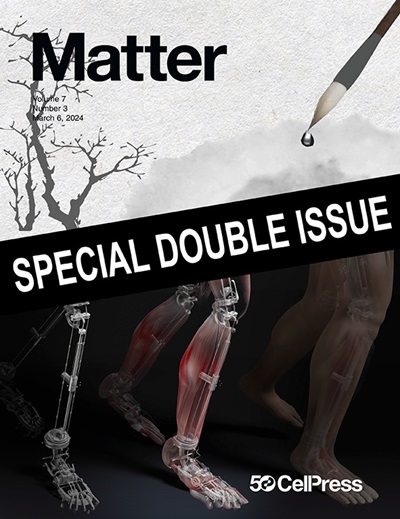混合维超晶格中的高温弹性双曲性
IF 17.3
1区 材料科学
Q1 MATERIALS SCIENCE, MULTIDISCIPLINARY
引用次数: 0
摘要
双曲超晶格用于亚波长聚焦、隐形和光学热管理。通常,这些超晶格是由贵金属层和绝缘体构成的。尽管这些系统具有优异的光学性能,但贵金属的热稳定性差阻碍了它们在高温环境中的应用。相反,在等离子体系统中,cmos兼容的过渡金属氮化物通常取代贵金属,因为它们以牺牲光学性能为代价具有高热稳定性。在这里,我们制备了具有3D-2D界面的双曲型氮化钛(TiN)/六方氮化硼(hBN)超晶格。界面的混合维性质阻止了原子在高温下通过界面扩散。发现在高温下(800℃退火5天),TiN/hBN的双曲度不受影响,并且发现TiN/hBN比类似的超晶格具有更大的双曲值。本文章由计算机程序翻译,如有差异,请以英文原文为准。

High-temperature-resilient hyperbolicity in a mixed-dimensional superlattice
Hyperbolic superlattices are used for subwavelength focusing, cloaking, and optical thermal management. Typically, these superlattices are constructed of layers of noble metals and insulators. Despite these systems displaying excellent optical performance, the poor thermal stability of noble metals prevents their application in high-temperature environments. Instead, CMOS-compatible transition-metal nitrides are often substituted for noble metals in plasmonic systems since they have high thermal stability at the expense of optical properties. Here, we fabricate hyperbolic titanium nitride (TiN)/hexagonal boron nitride (hBN) superlattices with 3D-2D interfaces. The mixed-dimensional nature of the interfaces prevents atoms from diffusing across the interface at high temperatures. The hyperbolicity of the superlattice is found to be unaffected by annealing at high temperature (800°C for 5 days), and TiN/hBN is found to have a larger hyperbolic figure of merit than similar superlattices.
求助全文
通过发布文献求助,成功后即可免费获取论文全文。
去求助
来源期刊

Matter
MATERIALS SCIENCE, MULTIDISCIPLINARY-
CiteScore
26.30
自引率
2.60%
发文量
367
期刊介绍:
Matter, a monthly journal affiliated with Cell, spans the broad field of materials science from nano to macro levels,covering fundamentals to applications. Embracing groundbreaking technologies,it includes full-length research articles,reviews, perspectives,previews, opinions, personnel stories, and general editorial content.
Matter aims to be the primary resource for researchers in academia and industry, inspiring the next generation of materials scientists.
 求助内容:
求助内容: 应助结果提醒方式:
应助结果提醒方式:


